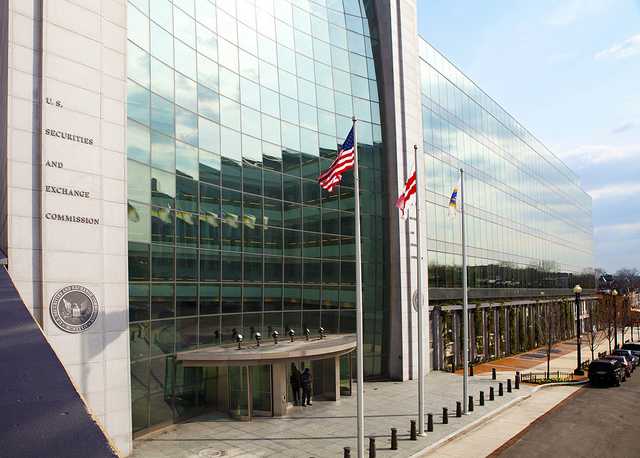
Leo Kolivakis is a blogger, trader and independent senior pension and investment analyst. This post was originally published at Pension Pulse.
Lisa Beilfuss and Aruna Viswanatha of the Wall Street Journal report, Blackstone in $39 Million SEC Settlement:
Blackstone Group LP agreed to pay about $39 million to settle Securities and Exchange Commission charges over some of the buyout-fund manager’s fee practices, in the agency’s second settlement with a big private-equity firm stemming from its broad examination of the industry.
The SEC said Wednesday that the New York firm failed to sufficiently disclose to its fund investors details about big one-time fees Blackstone collected from companies it sold or took public, as well as discounts the firm received on some legal fees that weren’t passed on to the fund investors. Nearly $29 million of the settlement will be distributed to affected fund investors, the SEC said.
Blackstone settled the charges without admitting or denying the SEC’s findings.
The settlement follows KKR & Co.’s June agreement to pay almost $30 million to settle SEC charges that it improperly allocated more than $17 million in expenses, hurting some investors while benefiting the firm’s executives and certain clients. KKR neither admitted nor denied the allegations.
“Our clear message to the entire private-equity industry is that this is an area of great risk, and that whatever the success of the fund over time, hidden or inadequately disclosed fees will not be tolerated regardless of the size of the adviser,” SEC Enforcement Director Andrew Ceresney said in announcing the Blackstone settlement.
The 2010 Dodd-Frank financial-regulation overhaul required private-equity funds to register with the SEC, giving the agency increased authority over the industry.
“This SEC matter arose from the absence of express disclosure in marketing documents, 10 or more years ago, about the possible acceleration of monitoring fees,” Blackstone said, calling the practice common in the industry. Blackstone voluntarily made changes to the applicable policies before the inquiry began, according to a company representative.
Blackstone, the world’s largest private-equity firm, last year curbed its collection of monitoring-termination fees, which are charged by many private-equity firms but have become controversial. Behind those fees are contracts that Blackstone and other large private-equity firms often enter into with companies they buy; the contracts spell out consulting, or “monitoring,” fees paid over a set number of years, often a decade or longer.
If a company is sold or taken public before end of that period, the contract often dictates that the portfolio company “accelerate” the remaining fees, by paying a lump sum for years of future consulting work the private-equity firm won’t have performed. The payments to Blackstone effectively reduced the value of the portfolio companies before sale, the SEC said.
The SEC has criticized these as a type of poorly disclosed “hidden” fee whose cost often is borne by public pension funds and other investors in private-equity funds.
In Blackstone’s case, the SEC said the firm had in most instances only taken the fees while maintaining some ownership stake in the company, but that in a few instances it took fees for a period of 1½ to several years for which it no longer had a stake in the company.
In addition to the monitoring fees, the SEC also took aim at Blackstone’s contracts with its lawyers. Between 2008 and 2011, the SEC said, Blackstone had an agreement with its law firm under which it received a discount on legal services that was “substantially greater” than the discount the funds received, but the difference wasn’t disclosed to the fund investors. The SEC didn’t say what the different rates were.
Adam Samson, Stephen Foley and Gina Chon of the Financial Times also report, Blackstone to pay $39m over SEC probe into fees:
Blackstone is to pay $39m in compensation and fines in the latest action by US regulators to stamp out hidden fees across the private equity industry.
The Securities and Exchange Commission accused the world’s biggest alternative asset manager of failing to fully inform investors about fee practices that it said eroded the value of their holdings.
The enforcement action comes 18 months after an SEC report found “violations of law or material weaknesses in controls” in the collection of fees and allocation of expenses at more than half of the 112 private equity managers the agency inspected.
Earlier this year, Blackstone rival KKR paid $28.7m in another SEC enforcement action, and the regulator also took action against two smaller private equity firms last year.
Andrew Ceresney, director of the SEC’s enforcement division, said the settlements with KKR and Blackstone covered specific practices and did not “imply closure”. The investigation of the industry is continuing, he said, and private equity firms should voluntarily report any historic fee practices they believe may not have been properly disclosed to investors.
The Blackstone settlement focuses on the acceleration of so-called “monitoring fees” that it charges portfolio companies.
Private equity companies charge fees for consulting with companies they own, sometimes with terms as long as a decade. In a bid to recoup what would be lost revenue, many private equity companies charge a large lump-sum fee ahead of a sale or when they take a portfolio company public.
The SEC alleged Blackstone failed to properly disclose the accelerated payment scheme to investors in its funds, which often count pension funds among their ranks.
“The payments to Blackstone essentially reduced the value of the portfolio companies prior to sale, to the detriment of the funds and their investors,” the SEC said on Wednesday.
The regulator also alleged Blackstone failed to tell investors that it had negotiated steep discounts for services from an outside legal firm that were not extended to the funds.
The scale and the complexity of fees paid to the $3.5tn private equity industry has become an increasing concern to public pension funds. In June, a group of senior elected US state officials wrote to the SEC calling on the agency to ensure that all private equity fees are reported clearly and consistently to investors.
The letter was signed by 13 state treasurers and comptrollers, including those in California and New York, who helped to provide oversight for public pensions.
Blackstone, led by Stephen Schwarzman, disclosed the SEC probe into monitoring fees and legal fee discounts in May, and said that it stopped or limited the charging of accelerated monitoring fees last year. It has also said it had beefed up disclosures over such fees.
“This SEC matter arose from the absence of express disclosure in marketing documents, ten or more years ago, about the possible acceleration of monitoring fees, a common industry practice,” Blackstone spokesman Peter Rose said.
“Each accelerated fee was, however, as the SEC order acknowledges, disclosed when received and our Limited Partner Advisory Committee did not exercise its right to object. Moreover, Blackstone voluntarily made changes to the applicable policies well before this inquiry was begun.”
The SEC said nearly $29m of the settlement will be distributed to affected fund shareholders.
Lastly, Dan Primack of Fortune reports, Blackstone Group settles with SEC over fees, will pay out $39 million:
Alternative investment giant The Blackstone Group (BX) this morning reached a settlement with the Securities and Exchange Commission, related to some of the firm’s former private equity fee practices.
Blackstone has agreed to pay a $10 million fine, plus refund nearly $29 million (including interest) to limited partners in its fourth and fifth flagship private equity funds. At issue were so-called accelerated monitoring fees, in which Blackstone effectively charged its portfolio companies for services not actually rendered (without properly disclosing such arrangements to its LPs). Here is how we described the scheme last October:
For years, Blackstone and many other private equity firms have charged something called “accelerated monitoring fees.” What it basically means is that, after buying a company, Blackstone would set an annual fee that the company would pay for various (often undefined and unverified) services. For example, $5 million per year for 10 years. The kicker is that if Blackstone exits the company prior to the 10 years being up — either via a sale or IPO — it gets the extra years in a lump sum payment.
Going forward, Blackstone no longer will write acceleration clauses into its monitoring fee agreements. For existing portfolio companies, it either will distribute 100% of the accelerated fee to limited partners or will cut other fees a commensurate amount.
The SEC also took issue with certain discounts that Blackstone received from law firms from legal work done for the parent company, but which were not also extended to its funds.
Word of the SEC investigation was first disclosed by Blackstone in a May regulatory filing.
“Full transparency of fees and conflicts of interest is critical in the private equity industry and we will continue taking action against advisers that do not adequately disclose their fees and expenses, as Blackstone did here,” Andrew Ceresney, director of the SEC’s enforcement unit said in a press release.
Blackstone spokesman Peter Rose provided the following statement via email:
“This SEC matter arose from the absence of express disclosure in marketing documents, ten or more years ago, about the possible acceleration of monitoring fees, a common industry practice. Each accelerated fee was, however, as the SEC order acknowledges, disclosed when received and our Limited Partner Advisory Committee did not exercise its right to object. Moreover, Blackstone voluntarily made changes to the applicable policies well before this inquiry was begun.”
Back in June, fellow private equity giant Kohlberg Kravis Roberts & Co. (KKR) settled with the SEC over charges that it breached fiduciary duty to investors in its flagship private equity funds between 2006 and 2011.
I’ve already covered hidden “monitoring fees” and hidden rebates from law firms and other third parties in a previous comment on private equity stealing from clients.
What Blackstone, KKR and others did is wrong and while these SEC settlements are a pittance for these alternative investment powerhouses, they represent a sea change for the industry which has prided itself in maintaining a culture of secrecy. The institutionalization of private equity, real estate and hedge funds has attracted regulators which are doing their job, monitoring the practices of these funds to make sure they’re in the best interests of their investors and shareholders.
What are my thoughts? I think these settlements will be forgotten soon enough and the reality is Blackstone, KKR and other alternative investment powerhouses have already taken steps to stop these practices.
Why are they doing this? Because the name of the game for these giants is asset gathering. Period. Paying a settlement of $39 million to the SEC after they took measures to cease these practices is well worth it if they can continue garnering ever more assets from public pension funds and sovereign wealth funds where they make exponentially more than these settlements just on the management fee alone.
And these SEC settlements won’t impact Blackstone’s fundraising activities in the least. In fact, it raised over $17 billion first close for its seventh global buyout fund back in May and it just raised $15.8 billion for its latest global real estate fund, Blackstone Real Estate Partners VIII where things are humming along just fine:
At present, the firm is managing two regional opportunistic real estate funds—the $8.2 billion Blackstone Real Estate Partners Europe IV and the $5 billion Blackstone Real Estate Partners Asia.
The alternative asset manager raised more than 90% of the money from institutional investors, according to people familiar with fundraising in March. Blackstone raised the remainder from the individual investors, a process that took longer to complete because of paperwork, said one person to Bloomberg.
How is Blackstone able to garner billions in assets? When you have people like Jonathan Gray and David Blitzer on your team, it’s not hard to see why investors love this firm. They are the best of breed in alternative investments, literally printing money in real estate, private equity, hedge funds and anything in between.
But things are getting tough for Blackstone and other private equity funds which is why the big shops are emulating the Oracle of Omaha’s approach, trying to collect ever more assets for a longer period, even if it means lower returns.
Still, with public markets getting hit, things are going to get a lot tougher for private equity superheroes which is one reason Blackstone’s shares have gotten hit lately (along with the market and shares of other alternative asset managers; click on images):
Finally, while it’s easy to point the finger at Blackstone, KKR, Carlyle and others, we should also pause and reflect on the role institutional investors play in tracking fees and hidden costs in their fund investments. I just wrote a comment on CalSTRS pulling a CalPERS on PE fees, criticizing both these giant funds for not doing enough to track and disclose private equity fees.
Matt Levine of Bloomberg touched on this last point in his comment, SEC Finds That Blackstone Charged Too Many Fees where he concludes:
As far as I can tell, this is a story of changing norms for private equity. Once upon a time, private equity was a sexy asset class that charged silly fees that were not subject to too much scrutiny by investors. (It was also a very well lawyered asset class that disclosed those fees reasonably clearly.)
But as returns have gotten less exciting, and as outside observers have called on public pension funds to pay more attention to what they pay for investing advice, limited partners have realized that some of the fees they paid to private equity firms were pretty silly. One response has been to stop paying those fees: Even before this SEC case, Blackstone got more conservative about accelerating monitoring fees, presumably because that’s what investors wanted.
But another response has been for investors to regret that they ever paid the fees in the first place, and to attribute that regret not to their own failure to care but to the private equity firms’ failure to disclose. There’s an obvious emotional appeal to that result — it’s much better to blame sophisticated Wall Street fat cats for overcharging than to blame public pension managers for overpaying — even though it doesn’t quite fit the facts.
Read Matt Levine’s entire comment here as he discusses many excellent points on the changing landscape in private equity and how institutional investors are responding (the smart ones are going Dutch on private equity).
Of course, you can read Yves Smith’s comment, SEC Gives Blackstone $39 Million Wet Noodle Lashing Over Private Equity Abuses, but not surprisingly, I find it too harsh.
Once again, if you have anything to add to this comment, feel free to email me at LKolivakis@gmail.com and I’ll be more than happy to edit and add your comments in an update.
Photo by Securities and Exchange Commission via Flickr CC License
















